#great british landscape painters
Explore tagged Tumblr posts
Text
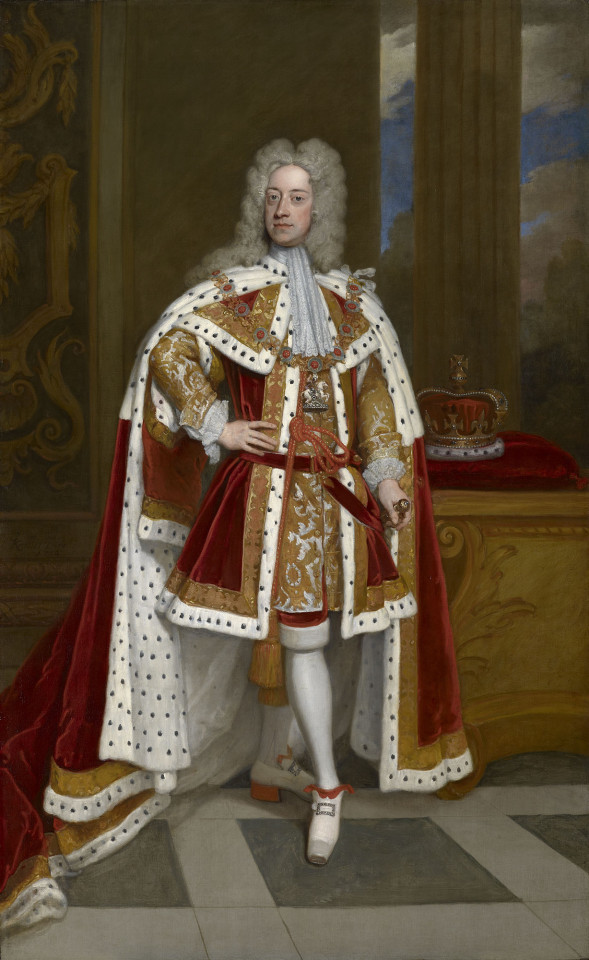
George II (1683-1760) When Prince of Wales
Artist: Sir Godfrey Kneller (German/British, 1646-1723)
Date: 1716
Medium: Oil on canvas
Collection: Royal Collection Trust, United Kingdom
Description
The future George II is shown wearing state robes with Collar of the Garter, his crown on the table to the right. As always with full-length portraits of this date the setting is imaginary but the ornamental plaster on wall is an interesting insight into the taste of the day.
#portrait#george II of great britain#full length#state robes#collar of the carter#crown#table#wig#classic column#landscape#british monarchy#british monarch#oil on canvas#fine art#oil painting#artwork#british culture#british art#british royal family#british history#sir godfrey kneller#german-british painter#european art#royal collection trust
17 notes
·
View notes
Text
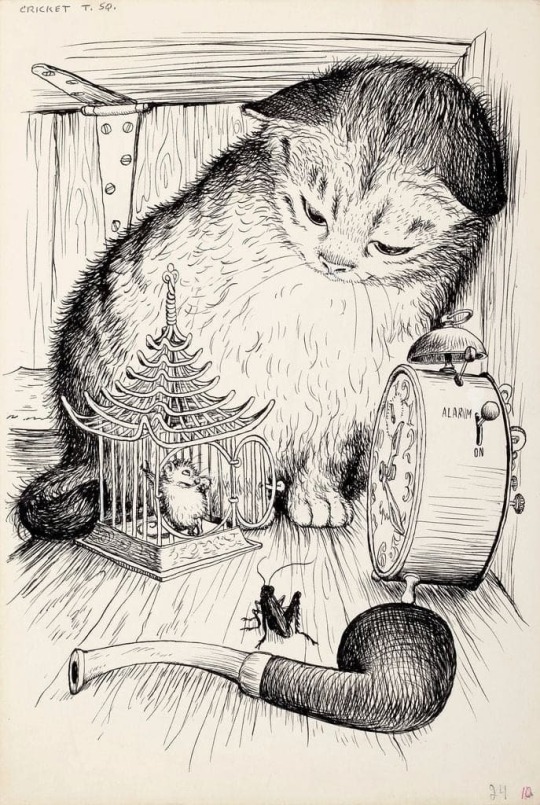
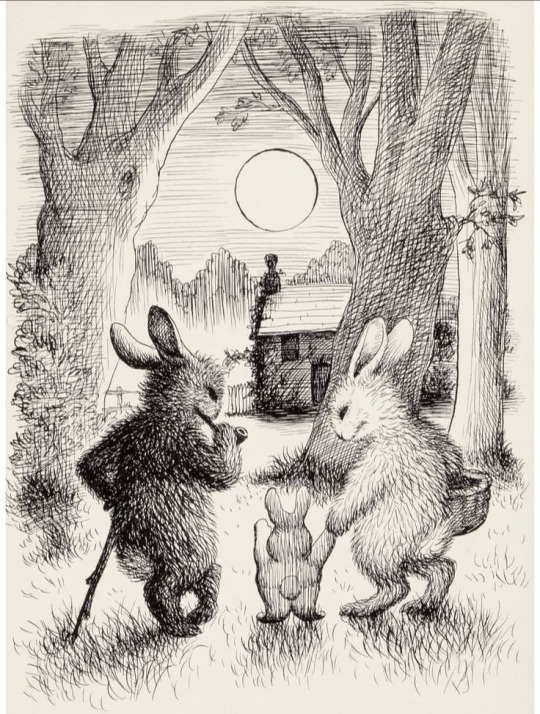


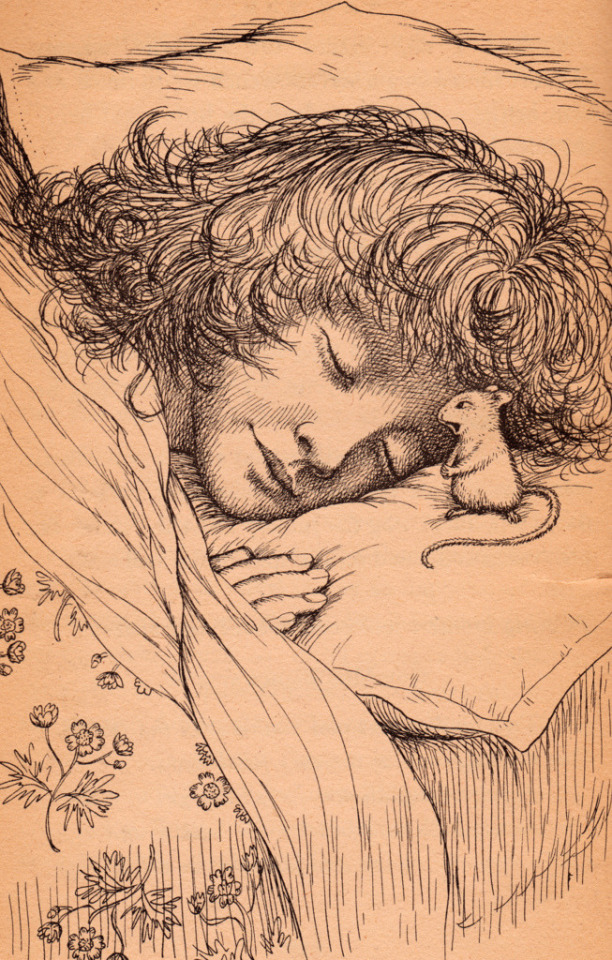
Garth Montgomery Williams (1912 – 1996) was an American artist and illustrator of children's books.
Gordon Campbell says in his book:
"In Stuart Little, Charlotte's Web, and in the Little House series of books of Laura Ingalls Wilder, Williams['s] drawings have become inseparable from how we think of those stories. In that respect ... Williams['s] work belongs in the same class as Sir John Tenniel's drawings for Alice in Wonderland, or Ernest Shepard's illustrations for Winnie the Pooh."
Born in New York City in 1912, Williams's father was a cartoonist for Punch and his mother was a landscape painter. He described them by saying, "Everybody in my home was always either painting or drawing." He grew up on farms in New Jersey and Canada until the family relocated to the United Kingdom in 1922, where his parents were from.
Williams studied architecture there, and worked for a time as an architect's assistant. When the Great Depression came, he made up his mind to be an artist instead of an architect. He began his studies at Westminster School of Art in 1929 and, in 1931, was awarded a four-year scholarship to the Royal College of Art where he created a sculpture that was awarded the British Prix de Rome. He continued his education at the British School at Rome in Germany and Italy, until the outbreak of World War II in Europe.
Cotinue reading
65 notes
·
View notes
Text
Rewind the Tape —Episode 1
Art of the episode
During our rewatch, we took note of the art shown and mentioned in the pilot, and we wanted to share. Did we miss any? Do you have any thoughts about how these references could be interpreted? How do you think Armand and Louis go about picking the art for their penthouse in Dubai?

The Fall of the Rebel Angels
Peter Bruegel the Elder, 1562
This painting is featured in the Interview with the Vampire book, and it was important enough to be included in the draft pilot script!

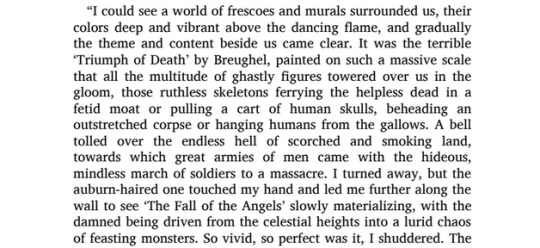
Bruegel the Elder was among the most significant Dutch and Flemish Renaissance artists. He was a painter and print-maker, known for his landscapes and peasant scenes.

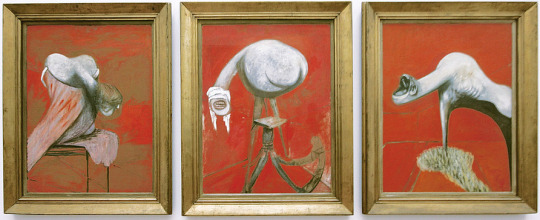
Three Studies for Figures at the Base of a Crucifixion
Francis Bacon, 1944
Bacon was an Irish figurative painter, known for his raw, unsettling imagery and a number of triptychs and diptychs among his work. At a time when being gay was a criminal offense, Bacon was open about his sexuality, and was cast out by his family at 16 for this reason. He destroyed many of his early works, but about 590 still survive. The Tate, where these paintings are displayed, says this about the work: "Francis Bacon titled this work after the figures often featured in Christian paintings witnessing the death of Jesus. But he said the creatures represented the avenging Furies from Greek mythology. The Furies punish those who go against the natural order. In Aeschylus’s tragedy The Eumenides, for example, they pursue a man who has murdered his mother. Bacon first exhibited this painting in April 1945, towards the end of the Second World War. For some, it reflects the horror of the war and the Holocaust in a world lacking guiding principles."
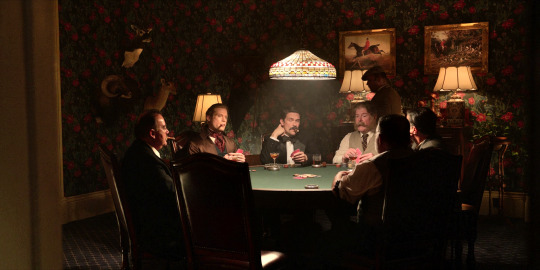
On the Hunt or Captain Percy Williams On A Favorite Irish Hunter and Calling the Hounds Out of Cover
Samuel Sidney, 1881 [Identified by @vfevermillion.] and Heywood Hardy, 1906 [Identified by @destinationdartboard.]
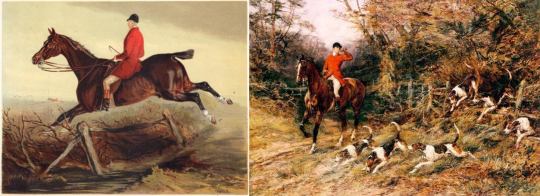
Sidney was an English writer, and his prints usually accompanied his publications about hunting, agriculture, and about settling Australia during the colonial period. Hardy, also British, was a painter, in particular an animal painter. There's also a taxidermy deer, ram, and piebald deer on the wall.
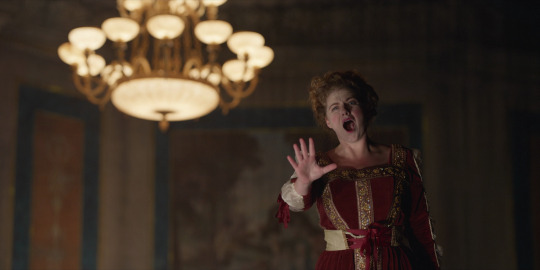
Iolanta
Pyotr Tchaikovsky, 1892
The opera Louis and Lestat go to was composed by Tchaikovsky, another gay artist. The play tells a story "in which love prevails, light shines for all, lies are no longer necessary and no one must fear punishment," as put by Susanne Stähr for the Berliner Philharmoniker.

Strawberries and Cream
Raphaelle Peale, 1816 [Identified by @diasdelfuego.]
Peale is considered to have been the first professional American painter of still-life.

Outfits inspired by J.C. Leyendecker
Leyendecker was one of the most prominent and commercially successful freelance artists in the U.S. He studied in France, and was a pioneer of the Art Deco illustration. Leyendecker's model, Charles Beach, was also his lover of five decades. You can read costume designer Carol Cutshall's thoughts on these outfits on her Instagram.

The Artist's Sister, Melanie
Egon Schiele, 1908 [Identified by @dwreader.]
Schiele was an Austrian expressionist painter and protege of Gustav Klimt. Many of his portraits (self portraits and of others) were described as grotesque and disturbing.
A Stag at Sharkey's
George Wesley Bellows, 1909 [Identified by @vfevermillion.]
Bellows was an American realist painter, known for his bold depictions of urban life in New York City.

Mildred-O Hat
Robert Henri, undated (likely 1890s) [Identified by @nicodelenfent, here.]
Henri was an American painter who studied in Paris, where he learned from the Impressionists and determined to lead an even more dramatic revolt against American academic art.
Starry night
Edvard Munch, 1893 [Identified by @vfevermillion.]
Munch was a Norwegian painter, one of the best known figures of late 19th-century Symbolism and a great influence in German Expressionism in the early 20th century. His work dealt with psychological themes, and he personally struggled with mental illness.
If you spot or put a name to any other references, let us know if you'd like us to add them with credit to the post!
Starting tonight, we will be rewatching and discussing Episode 2, ...After the Phantoms of Your Former Self. We hope to see you there!
And, if you're just getting caught up, learn all about our group rewatch here ►
#louis de pointe du lac#daniel molloy#lestat de lioncourt#vampterview#interview with the vampire#iwtv#amc interview with the vampire#interview with the vampire amc#amc iwtv#iwtv amc#IWTVfanevents#rewind the tape#in throes of increasing wonder#analysis and meta#art of the episode
97 notes
·
View notes
Text




On October 24th 1796 the artist, David Roberts, was born in Edinburgh.
The son of a shoemaker, who began his career as an apprentice house painter. Roberts was born in Stockbridge, near Edinburgh, and while a boy he was a frequent visitor to Rosslyn Chapel, it’s architecture is a complex fusion of influences from many cultures, and it has been mentioned that it was an immense inspiration to the painter.
At the age of 19, after studying art formally at night, Roberts became foreman of work at Scone Palace for a time. Returning home in search of a new job at the end of the project, he took work as a scenery painter for James Bannister’s circus. Bannister offered him more work, engaging him on a good salary of 25 shillings a week, and for a while Roberts toured the country with the circus.
Through Bannister, Roberts then found work at the Pantheon Theatre in Edinburgh, but when the venture failed, he returned to his trade of house painter and decorator. All the time he was working on the “day job”, he was also practising his sketching and painting, thus developing his fine art skills.
Roberts returned to painting scenery for theatres in Edinburgh and Glasgow, meeting his wife, the actress Margaret McLachlan, at the Theatre Royal in Edinburgh. They had one child, Christine. In the early 1820s he exhibited work at the Fine Arts Institution in Edinburgh, including scenes of the abbeys of Melrose and Dryburgh, which were popular themes due to the immense interest in the history of the Anglo-Scottish border created by the work of Walter Scott.
Roberts was offered work in London, at first by the Coburg Theatre and then the Theatre Royal in Drury Lane. Soon Roberts was commissioned to work for Covent Garden, while also successfully exhibiting at the British Institution. Gothic, romantic and religious themes were still popular in art and Roberts continued to produce paintings of Scottish abbeys and famous European Cathedrals. He developed his range into landscapes and seascapes, as well as Biblical and antiquarian themes, achieving fame though his painting “Departure of the Israelites from Egypt”.
Roberts began to travel in 1832, producing a series of lithographs from his trip to Spain and Morocco. In 1838, he embarked on a tour of Egypt, Nubia, Sinai, Syria and the Holy Land, and his sketches, paintings and lithographs were hugely in demand on his return. Publication of “Sketches in the Holy Land and Syria, 1842–1849” and “Egypt & Nubia” followed, volumes that ran to many editions and are still popular as reprints today.
When he returned to Scotland, the Royal Scottish Academy feted him at a public dinner. As a result of this, Roberts advised the Academy that he was worried about work that was being done at Rosslyn Chapel. One of the major architectural conflicts of the time was between the “romantic school” who viewed overgrown buildings as beautiful in their own right, even seeing the moss and overgrowth as protective, and those who wished to restore and preserve buildings.
When he returned to Scotland, the Royal Scottish Academy feted him at a public dinner. As a result of this, Roberts advised the Academy that he was worried about work that was being done at Rosslyn Chapel. One of the major architectural conflicts of the time was between the “romantic school” who viewed overgrown buildings as beautiful in their own right, even seeing the moss and overgrowth as protective, and those who wished to restore and preserve buildings.
Roberts also visited Italy in the early 1850s, producing a volume of paintings entitled “Italy, Classical, Historical and Picturesque”. The last 15 years of his life were spent carrying out prestigious projects such as the painting of the opening of the Great Exhibition of 1851. He became a member of the Royal Academy and was given the freedom of Edinburgh. His distinctive style and intuitive interpretation of light were emulated by many artists who came after him.
The last time I posted about David Roberts I featured his work in Palestine and Egypt, the pics this time around are his home grown work, the first being a self portrait, next is his apparent inspiration, the Entrance to the Crypt, Rosslyn Chapel, St. Mungo’s Cathedral, Glasgow and Dumbarton Rock.
If you want to see more of his work check out the Royal Academy's site here.https://www.royalacademy.org.uk/art.../name/david-roberts-ra
8 notes
·
View notes
Text

The Rev. John Chafy Playing the Violoncello in a Landscape
Artist: Thomas Gainsborough (English, 1727–1788)
Date: c. 1750-1752
Medium: Oil paint on canvas
Collection: TATE Britain
Description
Rev. John Chafy was the vicar at Great Bricett in Suffolk, near Sudbury where Thomas Gainsborough lived at this time. Chafy was a talented musician. Gainsborough too is known to have played several instruments with ‘native skill’ and played with the Ipswich Musical Club. Here, in the temple behind Chafy is a statue holding a lyre, the attribute of the Muses of dancing and love poetry. This is probably a reference to Chafy’s forthcoming marriage. Gainsborough was the most successful British portrait painter of the second half of the 18th century.
5 notes
·
View notes
Text

Philip Hermogenes Calderon, RA The Orphans 1870. Oil on canvas
Philip Hermogenes Calderon RA (Poitiers 3 May 1833 – 30 April 1898 London) was a British painter of French birth (mother) and Spanish (father) ancestry, who initially worked in the Pre-Raphaelite style before moving towards historical genre painting. He was Keeper of the Royal Academy in London.
Calderon was born in Poitiers, France. His father, the Reverend Juan Calderón (* 19 April 1791 in Villafranca de los Caballeros; † 28 January 1854 in London) was a professor of Spanish literature and a former Roman Catholic priest who had converted to Anglicanism. Calderon planned to study engineering, but he became so interested in drawing technical figures and diagrams that he changed his mind and devoted his time to art. In 1850, he trained at Leigh's art school, London, then went to Paris to study under François-Édouard Picot in 1851. His first successful painting was called By the waters of Babylon (1852), which was followed by a much more popular one called Broken Vows (1856). From the beginning he was inspired by the Pre-Raphaelites, and some of his work showed the detail, deep colors, and realistic forms that characterize the style. The artist Henry Stacy Marks was his friend and brother-in-law, and Calderon exhibited his portrait at the Royal Academy in 1872.
Calderon became a leading member of the St John's Wood Clique, a group of artists interested in modern genre and historical subjects who were inspired, both artistically and socially by the Pre-Raphaelites. Historical, biblical, and literary themes were common in Calderon's later work. Many of his pieces show women wearing rich, silky clothing in gently colored landscapes. His Morning (1884) features a copper-haired maiden watching a sunrise.
His Juliet (1888) shows Shakespeare's Juliet seated on her balcony gazing at the stars. His later paintings adopt a more classical style, comparable to Edward Poynter, which resulted from his close relationship with Frederic Leighton, then-President of the Royal Academy. Calderon became Keeper of the Royal Academy in 1887, and from then on worked to support the teaching of anatomy based on nude models at the Royal Academy Schools. His 1891 painting St Elizabeth of Hungary's great act of renunciation was secured by the Chantrey bequest for the national collection, and is now located in Tate Britain, but caused considerable controversy because of its perceived anti-Catholic message. It depicted the saint bending nude over an altar watched by monks.
4 notes
·
View notes
Photo

MWW Artwork of the Day (6/15/23) Edmund John Niemann (British, 1813–1876) Richmond on Thames (c. 1865-70) Oil on canvas, 76.3 x 127 cm. Private Collection
Niemann was a prolific and highly successful British landscape artist working mostly in oils. He was born in Islington, London in 1813. As a young man, Edmund was employed as a clerk at Lloyd's, but he decided to devote himself to art and in 1839 settled in High Wycombe, Buckinghamshire, mostly painting out of doors. Though he especially enjoyed painting the scenery of the Thames and of the River Swale, near Richmond in Yorkshire, many other areas of the British Isles are covered in the corpus of his work. His paintings are characterised by great versatility, natural colors, and visual realism, often in the romantic artistic style of J.M.W. Turner, Corot and Caspar David Friedrich. His son, Edward H. Niemann, was also a painter imitating his father's style.
5 notes
·
View notes
Text
(English / Español)
John Atkinson Grimshaw (Leeds 1836- 1893) was an imaginative British painter of the Victorian period, best known for his nocturnal scenes and landscapes.He began exhibiting in 1862, aided by theLeeds Literary and Philosophical Society, with paintings mostly of birds, fruit and flowers. Grimshaw was mainly influenced by the Pre-Raphaelite painters, especially the landscape painter John William Inchbold, also from Leeds. True to this style, he created landscapes of precise, luminous colour, vivid detail and realism, sometimes using photographs to ensure accuracy. He painted landscapes that typified the seasons or a moment of weather, street scenes of the city or suburbs, and moonlit views of the docks of London, Leeds, Liverpool or Glasgow. His careful brushwork and his ability to depict lighting effects enabled him to capture the aspects and atmosphere of the scenes in great detail. His "pictures of gas-lit wet streets and foggy docks convey a strange warmth and alienation of the urban scene.
-----------------------------------------------------------------------------
John Atkinson Grimshaw (Leeds 1836- 1893) pintor imaginativo británico de la época victoriana, conocido sobre todo por sus escenas nocturnas y paisajes. Comenzó a exponer en 1862, ayudado por la "Sociedad Filosófica y Literaria de Leeds", con pinturas, en su mayoría, de aves, frutas y flores. Grimshaw estuvo influenciado principalmente por los pintores prerrafaelitas, sobre todo por el pintor de paisajes John William Inchbold, también de Leeds. Fiel a este estilo, creó paisajes de colores precisos, luminosos, de vívido detalle y realismo, a veces, usando fotografías para asegurar la precisión. Pintó paisajes que tipificaban las estaciones o algún momento climático, escenas callejeras de la ciudad o los suburbios y vistas, a la luz de la luna, de los muelles de Londres, Leeds, Liverpool o Glasgow. Su cuidadosa pincelada y su habilidad para representar los efectos lumínicos le permitía capturar con gran detalle los aspectos y el ambiente de las escenas. Sus "cuadros de calles húmedas iluminadas con gas y de muelles entre la niebla, transmiten una extraña calidez y una alienación de la escena urbana".

-Whitby Harbor by Moonlight-
240 notes
·
View notes
Text
6 Famous Museums in Cameroon
Situated in Western Africa, Cameroon is a dynamic nation that provides a vast array of cultural and historical experiences. Cameroon is a country with a variety of landforms, ranging from coastal plains and plateaus to mountains and plains and it borders nations like Nigeria, Chad and the Central African Republic. German colonial rule and then French and British mandates molded Cameroon's complicated past which is reflected in the country's cultural icons. Visiting its well-known museums offers a unique window into the past and present of this intriguing country for history buffs and tourists wanting to discover its core. Make sure you obtain your Cameroon visa before leaving on your trip to ensure a unique cultural experience.
The museums in Cameroon provide a fascinating experience that showcases the vast cultural, artistic and historical diversity of the nation. These organizations which can be found in both the seaside resort of Douala and the energetic capital city of Yaoundé not only conserve the country's cultural legacy but also highlight its historical development. These museums aim to provide a profound grasp of Cameroon's identity, regardless of whether you are an art enthusiast, history buff or just interested in learning more about the country's unique cultural landscape. Explore our guide to learn about the top six Cameroonian museums you should not miss.
Here are the 6 Famous Museums in Cameroon:
1. Station Bandjoun:
The renowned painter Barthélémy Toguo of Cameroon is the founder of the grandiose project known as Bandjoun Station. This one-of-a-kind museum has a concept that goes beyond standard museum limits serving as a cultural hub that unites art with community development. In addition to being an art gallery, Bandjoun Station also organizes seminars, international art partnerships and exhibitions that showcase current African art and culture. Toguo wants to transform Bandjoun Station into a thriving hub for artistic exchange by creating an environment that encourages innovation and conversation between regional and global artists.
Travellers traveling between these important places will find Bandjoun Station conveniently located along the Bamenda-Bafoussam-Yaoundé highway. The peaceful surroundings of the museum are ideal for contemplation and appreciating art. In addition to its creative pursuits, Bandjoun Station engages in farming activities that benefit the neighbourhood and encourage self-sufficiency and sustainable growth. Because of the way that art and agriculture are combined, Bandjoun Station is a very special place that offers travellers a wide range of experiences that have a positive social and cultural influence.
2. Yaoundé National Museum:
Housed in the ancient presidential palace, the National Museum of Yaoundé offers an impressive setting for a vast array of historical items. The museum's displays which feature a range of priceless artefacts spanning ages provide a thorough picture of Cameroon's past. Visitors can take a guided tour of the first level, which uses a powerful series of images and artefacts to vividly depict recent events. These exhibits shed light on Cameroon's post-colonial development and the major occasions that have influenced the country. The great riches are located on the higher levels of the National Museum of Yaoundé.
3. Douala’s Maritime Museum:
A fascinating look into Cameroon's maritime past can be found at the Musée Maritime de Douala which reflects the importance of the sea to the nation. This museum offers an educational journey through the marine legacy that has shaped the development of the region. It is located in Douala the main city and economic center of Cameroon. Aspects of nautical life such as historical naval operations, customary fishing methods and the development of maritime commerce in the area are all covered in the displays.
The Musée Maritime de Douala normally closes in one to two hours giving visitors plenty of time to peruse its wide range of exhibits. The museum's interactive displays, historical maritime relics and traditional boat models appeal to visitors of all ages. In addition to highlighting the sea's historical significance to Cameroon's economy and culture the educational displays also emphasize current marine challenges and conservation initiatives. This museum is essential for everyone who wants to comprehend the significance of maritime operations in Cameroon's past and present.
4. Museum of Blackitude:
The Blackitude Museum, established by the Bahouoc tribe's royal line is a veritable gold mine of Cameroonian art and culture in Yaoundé. Aiming to conserve and promote the cultural legacy of Cameroon's numerous ethnic groups this museum features an amazing array of objects, such as traditional masks, sculptures, ceramics and textiles. The displays at the museum offer a thorough exploration of the artistic creations and cultural customs that have been handed down through the ages.
Those who visit the Blackitude Museum can anticipate being enthralled by the fine craftsmanship and deep symbolism present in the objects on exhibit. A fuller understanding of Cameroon's cultural legacy is promoted by workshops, performances and educational initiatives held within the museum which also functions as a cultural hub. Participating in these events helps tourists understand the customs and creative accomplishments of the Cameroonian people. Make sure you have your Cameroon visa before making travel plans so you may enjoy this cultural oasis.
5. The Museum of Babungo: Situated in Cameroon's Northwest Region, the Babungo Museum provides a unique perspective on the art and history of the Babungo Kingdom. The collection of sculptures in the museum is evidence of the sculpting prowess long admired by the kingdom's kings. Considered among the best examples of Grasslands art, the elaborate bronze statues depicting all facets of Babungo life and history are on display for visitors to appreciate.
To illustrate the changing artistic expressions in the kingdom the Babungo Museum has included plastic art to its collection in addition to traditional sculptures. The museum protects Babungo legacy while also acting as a vibrant meeting point for modern and traditional art forms. The museum is a fascinating location for art lovers and cultural aficionados because of its blend of old and new which offers a thorough insight of the Babungo culture.
6. The Museum and Palace of Mankon The Mankon Museum housed in the storied Fon's Palace, has about 200 artefacts that provide insight into the rich cultural legacy of the Mankon people. Traditional attire, weaponry and ceremonial artefacts are all on display in the museum; each has a distinct past and meaning. The headgear collection which includes the German helmet and armor worn by the Fon is one of the highlights. It represents the blending of native and colonial elements.
In addition the Mankon Palace is a thriving hub for creative and cultural exchanges holding regional artistic traditions' support through events and exhibitions. Discover more about the exquisitely maintained palace gardens and have a greater understanding of the Mankon people's rich cultural and historical heritage. The Mankon Museum is a living tribute to the continuing customs and artistic accomplishments of this extraordinary people, not only a storehouse of items.
Conclusion:
Investigating Cameroon's museums is a singular and rewarding way to experience the dynamic cultural and historical landscape of the nation. Every museum offers a unique viewpoint on Cameroon's past from the cutting-edge agricultural technologies and modern art at Bandjoun Station to the priceless historical treasures kept at the National Museum of Yaoundé. African art is on display at the Blackitude Museum while the nation's nautical traditions are encapsulated in the Musée nautical de Douala. Deep insights into the creative and cultural accomplishments of the Babungo and Mankon peoples, respectively may be found in the Babungo Museum and the Mankon Palace and Museum. These museums foster cross-cultural dialogue and understanding in addition to protecting Cameroon's rich cultural heritage.
To ensure a hassle-free and seamless travel experience make sure you have obtained your Cameroon visa prior to starting this cultural journey. You will definitely have a deeper understanding of Cameroon's history, culture and art if you visit these museums. These museums guarantee to provide an amazing study of Cameroon's cultural wealth, regardless of your interests—art, history or just general curiosity. Plan your travel, obtain a Cameroon visa and get ready to explore the fascinating world of Cameroonian culture.
0 notes
Text

Carnations, 1995 Carolyn Sergeant (1937-2018, British)
Carolyn Sergeant is a botanical and landscape artist of great sensitivity. Her work ranges from freely handled depictions of still life subjects, interiors and the familiar landscapes around her home in the Welsh Marches to detailed depictions of single blooms set against rich, monochrome backgrounds. Carolyn Sergeant has exhibited widely, with major exhibitions at Colnaghi, Hazlitt and the Fine Art Society in recent years. Other painter's works: https://www.artnet.com/artists/carolyn-sergeant/
#dianthus#carnation#painting#still life#flowers#flower vase#women in art#woman painter#20th century art#20th century painting#carolyn sergeant
0 notes
Text
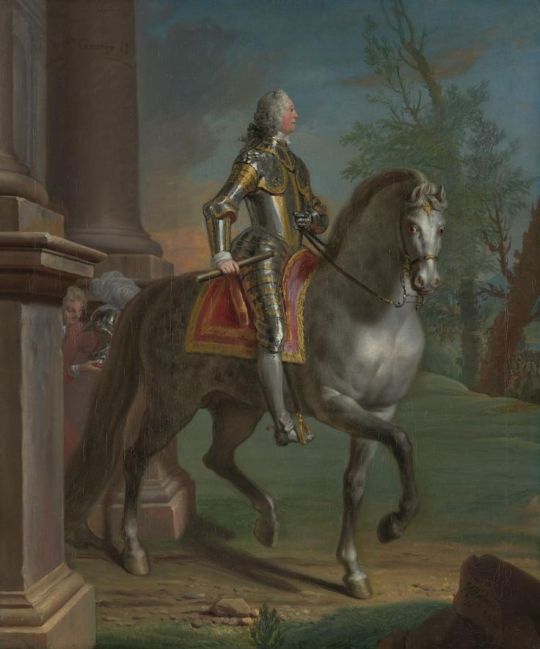
Equestrian Portrait of King George II
Artist: Joseph Highmore (English, 1692–1780)
Date: c.1743–1745
Medium: Oil paint on canvas
Collection: TATE Britain, London, United Kingdom
Description
Highmore may have painted this small equestrian portrait of George II as a preliminary design for a life-size portrait that remained unexecuted. Several celebrated life-size equestrian portraits, notably those of Anthony Van Dyck and Titian, influence the composition. Although the King wears a fanciful suit of ‘antique’ armour, the portrait may allude specifically to his actual role at the battle of Dettingen in 1743, when he led British and Hanoverian troops to victory against the French. Cosmo, 3rd Duke of Gordon, one of the king’s staunchest allies, probably commissioned the picture.
#portrait#painting#equestrian portrait#king george ii#king of great britain and ireland#fine art#oil paint on canvas#artwork#british culture#landscape#classical columns#horse#armour#trees#architecture#human figures#british monarchy#house of hanover#english painter#joseph highmore#british art#tate britain#18th century painting
12 notes
·
View notes
Text
John Martin (19 July 1789 – 17 February 1854) was an English Romantic painter, engraver and illustrator. He was celebrated for his typically vast and dramatic paintings of religious subjects and fantastic compositions, populated with minute figures placed in imposing landscapes. Martin’s paintings, and the prints made from them, enjoyed great success with the general public—in 1821 Thomas Lawrence referred to him as “the most popular painter of his day"—but were lambasted by John Ruskin and other critics.
Sadak in Search of the Waters of Oblivion is an 1812 oil painting by John Martin. It has been called "the most famous of the British romantic works"; it was the first of Martin's characteristically dramatic, grand, grandiose large pictures, and anchored the development of the style for which Martin would become famous.
The painting shows a human figure climbing in a mountain landscape. The man struggles to surmount a rocky outcrop beside a pool and waterfall; more jagged cliffs and peaks loom in the background, vastly receding. Martin later stated that he finished the work in a month. And he wrote, "You may easily guess my anxiety when I overheard the men who were to place it in the frame disputing as to which was the top of the picture! Hope almost forsook me, for much depended on this work." (At the time, Martin had left his £2-per-week job as a glass painter in a china factory, and was attempting to establish himself as an independent artist.)
The artist's anxiety was unnecessary; displayed in the Royal Academy exhibition at Somerset House, the picture was a popular success. It was purchased for fifty guineas by William Manning, a member of the board of governors of the Bank of England. Reportedly, Manning's "dying son had been moved by its depiction of the slight solitary figure clinging perilously to a ledge."
For many years the painting was known only in a reduced version in the Southampton City Art Gallery. The full-size original was discovered in Sweden and acquired by the Saint Louis Art Museum in 1983.
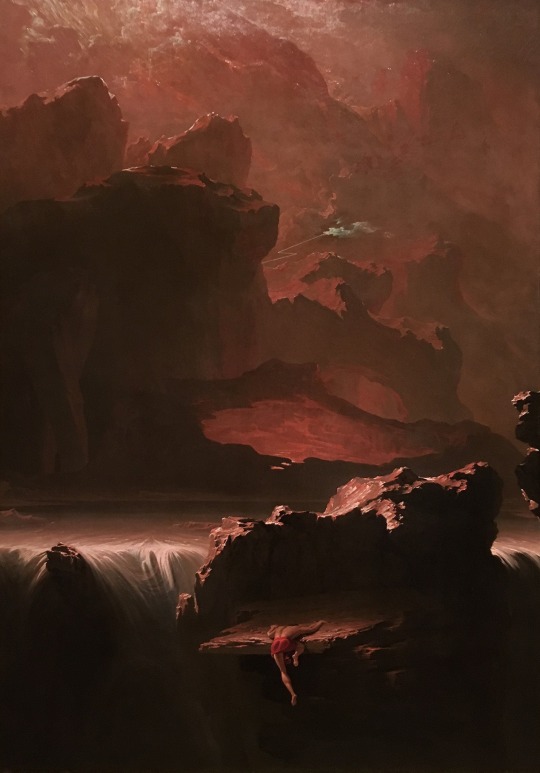
Sadak in Search of the Waters of Oblivion by John Martin
556 notes
·
View notes
Text

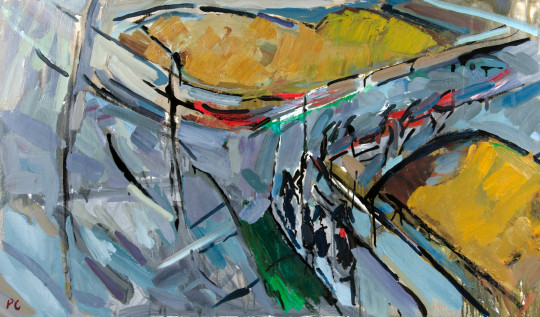

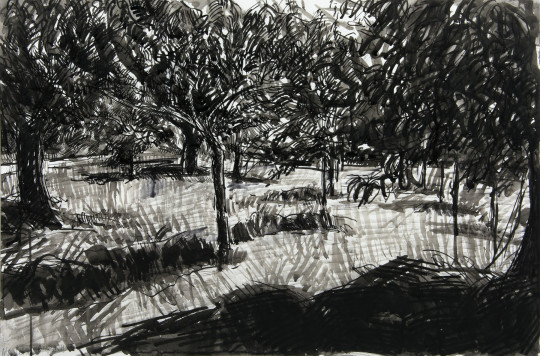



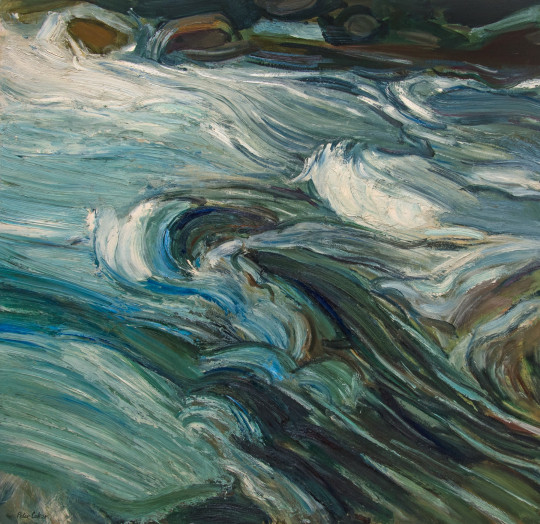
Peter Coker, RA (British, 1926-2004)
‘One of the foremost realist painters in England … Coker will be remembered for the refreshing nature of his astringent vision, for his consummate mastery as a draughtsman, painter and etcher, and as a proud and vigorous inheritor of a great artistic tradition.’ (Frances Spalding, Independent, 20 December 2004)
Peter Coker was born in London on 27 July 1926. He first studied at St Martin’s School of Art (1941-43; 1947-50), and began to exhibit regularly at the Royal Academy from 1950. Though he was a contemporary of John Bratby and Edward Middleditch at the Royal College of Art (1950-54), his work related only briefly to the raw figuration of the Kitchen Sink School. This was signalled by his paintings of a Leytonstone butcher’s shop which were included in his highly successful first solo show (Zwemmer Gallery 1956). His development as a landscape painter originated in his first encounter with the canvases of Gustave Courbet on a trip to Paris (1950). By the mid 1950s, he was an established landscapist in the French manner, working from the motif on the coasts of Normandy (1955) and Brittany (1957), and drawing inspiration from such contemporaries as Nicholas de Stäel. Later in the decade, he revived the spirit of Barbizon in his paintings of Epping.
Coker moved with his family to Manningtree in Essex (1962), and added occasional appearances at Colchester School of Art to teaching at St Martin’s. Nevertheless, he concentrated on his work, and made time for painting trips to France, the North of England and Scotland. He held solo shows at the Zwemmer Gallery (1960s), the Thackeray Gallery (1970s) and Gallery 10 (1980s), and continued to exhibit regularly at the Royal Academy. He was elected an Academician (ARA 1965, RA 1972), and had his early images of the butcher’s shop presented at the RA in one of an increasing number of public retrospectives (1979).
From 1972, Coker made several visits to Bargemon, Provence, during which he gradually accepted the character of the South of France, and integrated its startling light and colour into his established palette and handling. Late in the decade, he applied this approach to an ideal motif, in beginning a series of paintings of the garden of the Clos du Peyronnet, Menton. Following the death of his son Nicholas in 1985, he stayed at Badenscallie, Ross-shire, Scotland. There he began an impassioned series of landscapes, extended on subsequent visits, which focussed on salmon nets drying at Achiltibuie. These reaffirmed his essential identity as ‘a northern painter’, which had actually become more strongly emphasised by his contrasting achievement of painting the south. The many studies and paintings inspired by both Mediterranean France and the West of Scotland comprised important elements of such recent retrospectives as that of drawings and sketchbooks at the Fitzwilliam Museum (1989) and that of paintings and drawings at Abbot Hall Art Gallery (1992).
In October 2002, Chris Beetles mounted a major retrospective of the work of Peter Coker and, at the same time, launched the artist’s authorised biography. The beautifully produced hardback book, with over 250 illustrations, contains contributions from Richard Humphreys (Tate Gallery), John Russell Taylor (The Times), and David Wootton (Chris Beetles Ltd). The book includes a comprehensive biography and chronology, essays, appraisals of his work, a catalogue raisonné and lists of his exhibitions and sketchbooks.
While the monograph and retrospective were being planned, it seemed that the artist’s career might have been drawing to a close. However, the joint project revived his energies significantly. This was manifested by a range of new work, which was shown at Chris Beetles Ltd during spring 2004. The motifs are mostly familiar, being drawn from existing sketchbooks, and range across France and encompass Britain. Yet the handling was freer than ever, and the palette more vibrant – accomplishments of which Peter was justifiably proud. This display was complemented by an exhibition of recent Parisian subjects, touring to Gainsborough’s House, Sudbury, the Royal Academy of Arts, and the Graves Art Gallery, Sheffield.
Peter Coker died in Colchester, Essex, on 16 December 2004.
11 notes
·
View notes
Text
Studio Project 2: Self-Directed Research
Artist Research
Francesco Clemente
Often classified as a Neo-Expressionist, Francesco Clemente makes rich gouache paintings and pastel drawings that range from distorted portraits to dreamlike scenes of violence and eroticism. Throughout his strange figurations, Clemente depicts corporeal details such as mutilated limbs, floating eyes, and intertwined bodies with a surrealistic detachment and sense of sublime symbology: Clemente, who splits his time between New York and Varanasi, India, is particularly inspired by Indian mysticism, art, and culture. The artist has exhibited in New York, Milan, Rome, London, Amsterdam, Madrid, and Zürich. Clemente’s work has sold for up to six figures on the secondary market and belongs in the collections of the Art Institute of Chicago, the Centre Pompidou, the Guggenheim Museum, the Metropolitan Museum of Art, the Museum of Modern Art, the Rubell Museum, the Stedelijk Museum, and the Tate.
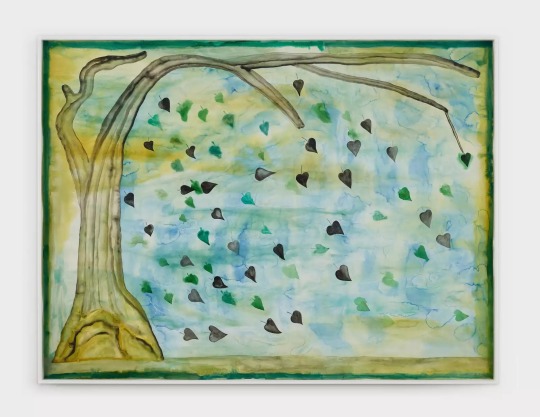
Air, 2021
Watercolor on paper
60 × 80 in | 152.4 × 203.2 cm
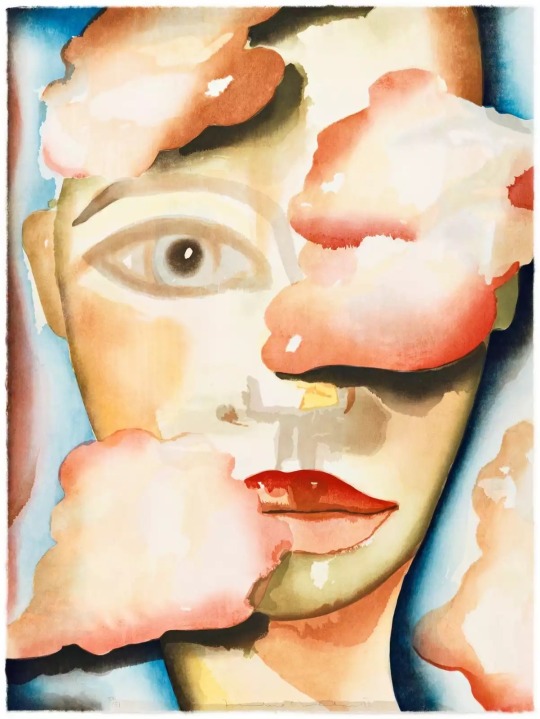
Air, 2007
Twenty-seven color Ukiyo-e woodcut hand-printed from 21 woodblocks
24 × 18 in | 61 × 45.7 cm
Edition 1/51
Inka Essenhigh
Inka Essenhigh (b. 1969, Bellefonte, PA) received her Master of Fine Arts from School of Visual Arts, New York, NY and her Bachelor of Fine Arts from Columbus College of Art & Design, Columbus, OH.
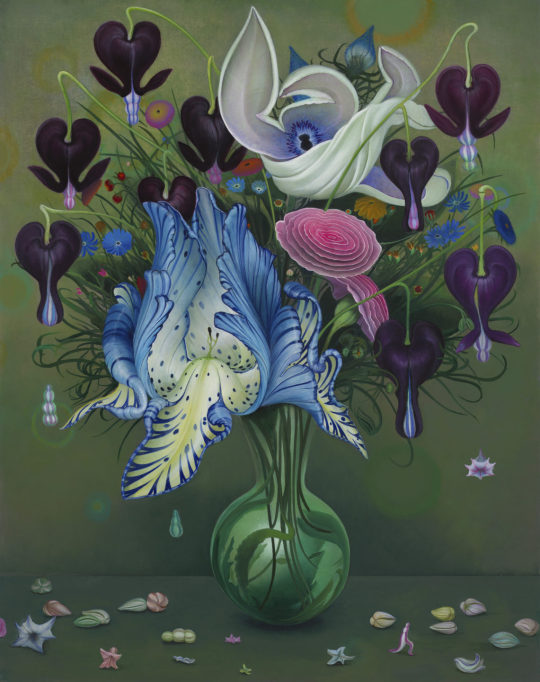
Inka Essenhigh, "Bleeding Hearts" (2021), Enamel on semi-rigid canvas, 121.9 x 96.5 cm, 48 x 38 in
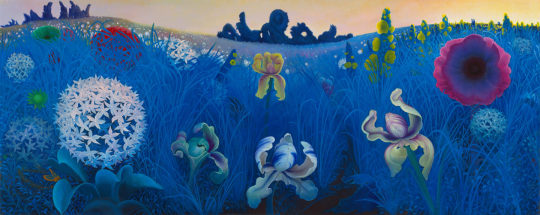
Inka Essenhigh, Blue Field, 2021
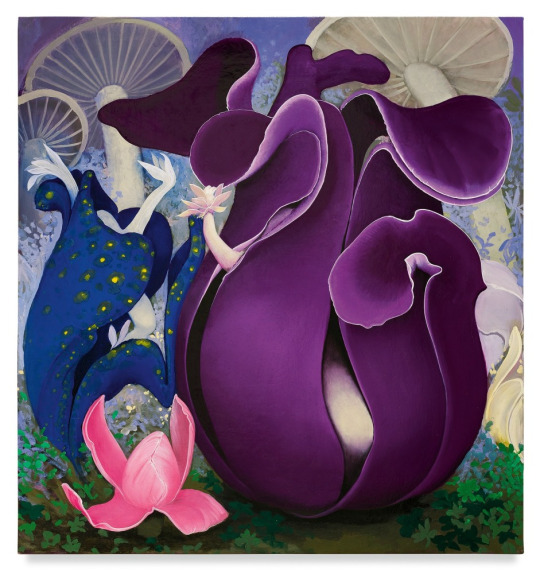
Inka Essenhigh, Purple Pods, 2019, Enamel on canvas, 34 x 32 inches
She paints a fluid, dreamy, fantasy landscape of animated, human-like trees and biomorphic beings – almost always women – veering towards a narrative art.
Chris Ofili
Introduction Christopher Ofili, (born 10 October 1968) is a British painter who is best known for his paintings incorporating elephant dung. He was Turner Prize-winner and one of the Young British Artists. Since 2005, Ofili has been living and working in Trinidad and Tobago, where he currently resides in the city of Port of Spain. He also has lived and worked in London and Brooklyn. Ofili has utilized resin, beads, oil paint, glitter, lumps of elephant dung and cut-outs from pornographic magazines as painting elements. His work has been classified as "punk art." WikidataQ1077608

Chris Ofili, The Great Beauty, 2020-2023, oil and charcoal on linen, 200 x 310 cm, 78 3:4 x 122 in © Chris Ofili. Courtesy the artist and Victoria Miro
"The Seven Deadly Sins are paintings in constant transition: between surface and depth, figure and foliage, light and dark; between mythology and religion, the sacred and profane."
"Nicholas Serota, who recently retired from his twenty-nine-year reign at the Tate, told me that Doig’s paintings “have a kind of mythic quality that’s both ancient and very, very modern. They seem to capture a contemporary sense of anxiety and melancholy and uncertainty. Lately, he’s gone more toward the sort of darkness we associate with Goya.”
"Ornamentation and visual excess have always featured in Ofili’s art"

Almost medieval … Chris Ofili, Requiem, 2023 (detail) commissioned for Tate Britain’s north staircase. Photograph: Thierry Bal/© Chris Ofili. Courtesy the artist
Emily Eleveth
Emily Eveleth is widely known for her paintings of jelly doughnuts. In fact, The Boston Globe wrote about this fascination in a 2008 article called “It’s time to paint the doughnuts.” She has had over 20 solo shows in museums and galleries on the East Coast, and received masters’ degrees from Smith College and the Massachusetts College of Art.
Spanning the boundaries between portrait, landscape, and object of projected desire, Emily Eveleth’s paintings form a genre unto themselves. Her ongoing series of paintings of doughnuts invests this unlikely subject with unexpected presence and identity. "Eveleth's paintings restlessly shift across a spectrum of meanings, covering along the way all the distances between opposing significances; prosaic and profound, profane and sacred, banal and intriguing, to say nothing of the axis between cool asexuality and gushing, if veiled, sexuality." *
In her concurrent series of figurative images lone figures stand in enigmatic isolation. Lost in private worlds the figures "seem to invite the viewer's gaze, acknowledge it, and then absorb it, folding it into their own particular dramas." ** These figurative projections of doubt and uncertainty appear paradoxical to their central declarative placement and openness. The dramatic lighting's interdependence on the rich enveloping darkness allows the figures to simultaneously emerge from and be enveloped by the inky space, projecting a quiet vulnerability.
Rashid Johnson
My works for the self-directed project depict a series of nightmares stemming from pain, anxiety, trauma, and several other mental health disorders. With the use of Vanitas Symbolism – the kind of painting that was popularised in the 17th century, often featuring still-life arrangements, including fruits, flowers, and other objects as symbols of the transience of life and the inevitability of death, I incorporate symbols of decay, such as wilting flowers or rotting fruits to convey the idea that even the most beautiful and vibrant aspects of life are subject to decay and eventual demise, suggesting a connection to human anguish and the fragility of existence. Moreover, I place decaying or withering fruits or flowers alongside depictions of human suffering or anguish to create a parallel between the ephemeral beauty of nature and the transient nature of human existence. The alignment between the fragile blooms and the sombre or distressed subject matter can evoke feelings of sorrow, mortality, or the fleeting nature of happiness. Plus, fruits and flowers are used metaphorically to represent human emotions and experiences. The work depicting a wilting flower or a bruised fruit symbolises a person's fading or wounded spirit undergoing emotional distress or pain. Similarly, an arrangement of fruits cut open or damaged serves as a metaphor for a human subject's inner turmoil or vulnerability. In terms of the colour palette, the one chosen for the fruits and flowers in a painting contributes to the depiction of human anguish. Dark, muted, or desaturated colours are used to represent sadness, despair, or suffering, while various parts are depicted with sharp contrasts between vibrant and sombre hues can create a sense of tension or conflict.
Georgia O'Keeffe: Known for her large-scale close-up floral paintings, Georgia O'Keeffe often explored the sensual and symbolic qualities of flowers. While her works are not explicitly focused on human suffering, they often evoke a sense of introspection, vulnerability, and emotional depth. Her magnified flower paintings, such as "Black Iris" or "Calla Lily Series," can be interpreted as metaphors for the human experience, including anguish and desire.
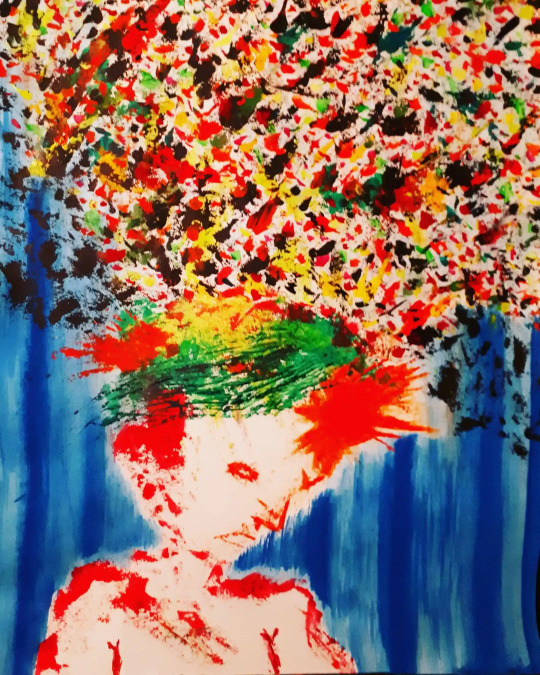
Mind Vomit
‘This represents the daily conversation within my mind. Anxious thoughts, depressive thoughts, sub-thoughts, thoughts about the thoughts, a constant critical commentary and a tornado of darkness, numbness and complete inner turmoil.’
Goya’s disasters of War
Jake & Dinos Chapman
destroyed bodies | Otto Dix
George Grosz
0 notes
Text

"Trains of the Future" Inspired by Joseph Mallord William Turner
⭐Shop now at www.cutehomeart.com⭐
A Modern Take on J.M.W. Turner's Legacy
"Trains of the Future" is a captivating and innovative piece of art that pays homage to the renowned artist Joseph Mallord William Turner, while simultaneously bringing his vision into the 21st century. This magnificent painting embodies the essence of Turner's romanticism and love for atmospheric landscapes, while integrating the excitement and innovation of modern transportation.
J.M.W. Turner: The Master of Light and Atmosphere
Joseph Mallord William Turner, often referred to as the "painter of light," was a prolific British artist known for his masterful landscape paintings and seascapes. His unique approach to capturing light, weather, and atmospheric effects has made his work iconic and unforgettable. Turner's artistic prowess laid the foundation for impressionism and inspired generations of artists, even to this day.
The Inspiration Behind "Trains of the Future"
"Trains of the Future" draws inspiration from Turner's masterpiece, "Rain, Steam, and Speed – The Great Western Railway." This original painting depicted a powerful steam locomotive hurtling through a stormy landscape, showcasing Turner's ability to capture the spirit of the Industrial Revolution. With the world changing rapidly around him, Turner expertly conveyed the energy and dynamism of his time.
In "Trains of the Future," the artist has reimagined Turner's vision, replacing the steam locomotive with a sleek, high-speed train racing through a similarly dramatic landscape. This contemporary adaptation celebrates human ingenuity and our ability to innovate and adapt, just as Turner did in his time.
"Trains of the Future": A Fusion of Tradition and Modernity
This stunning painting embodies the perfect blend of Turner's romanticism and our current era's fascination with cutting-edge technology. The high-speed train, representing the pinnacle of modern transportation, is expertly rendered in Turner's signature atmospheric style. The stormy skies and swirling clouds evoke a sense of movement and progress, as if the viewer is being transported into the future.
A Timeless Tribute to J.M.W. Turner
"Trains of the Future" is a testament to Turner's enduring impact on the world of art. By skillfully combining the essence of his work with contemporary themes and imagery, the artist has created a unique and captivating piece that will be cherished for generations to come.
In conclusion
"Trains of the Future" is not only a remarkable painting in its own right but also a celebration of Joseph Mallord William Turner's artistic legacy. This beautiful work of art serves as a bridge between past and present, honoring Turner's genius while inspiring new creative expressions. Don't miss the opportunity to own this one-of-a-kind piece that pays tribute to one of the greatest artists in history.
#art#culture#art history#artwork#painter#painting#artblog#wall art#home decor#cute art#train art#trains of the future#inspired art#modern art#futuristic art
0 notes
Text
The Painters of Stives
The small coastal town of Stives is steeped in art history and the paintings and sculpture that can be seen here reflect the many artists who have come and gone through the years. From the late 19th century, a group of modernist painters Stives came to call the village home, creating a community that became known as the 'Stives School'.
The art of Stives was an important part of British artistic culture, particularly during the period when it was at the forefront of the international modern movement. A number of the pioneers of British abstract painting came from Stives. These included Alfred Wallis, Ben Nicholson, Barbara Hepworth and Terry Frost.
Artists like Hepworth and Nicholson drew inspiration from the local landscape in their work, while others such as Nicholson and Wallis were more focused on the abstract side of the art world. This influence is apparent in their paintings, which often feature abstract shapes, patterns and lines with a strong emphasis on color and light.
Another influential figure in the art of Stives was Bernard Leach, a potter who made pots and glazed tiles from discarded materials. He was a direct link to the local culture of'simpleness' that the artists of Stives sought to emulate.
Painters also took inspiration from the sea and the local landscape, such as in the works of Thomas Laurence. He portrayed the sea, harbours and beaches of the town with great accuracy. His depictions of the local people were highly popular, and his paintings were bought by many of the area's residents.
He was a member of the Stives School, which was founded by a group of painters who lived in the town. This group of artists remained together until 1914, when the outbreak of war meant that most of them moved on to London.
Although they left, the 'Stives School' remains an important artistic movement that is still widely respected today. It was a place where modernist painters found their creative expression and a place that helped them develop their individual styles. The Stives School, as a result, remains one of the most significant contributions to the British abstract art movement.
Offering quality services in the best possible pricing is the motto of Salma Painting and Decorating Services. Having started out in the year 2003, over the years, we have grown our clientele and engaged in a range of painting and decorating services for commercial, residential and industrial segments.
#Painters Rose Bay#Painters Ryde#Painters Stives#Painters Strathfield#PAINTERS SUMMER HILLS#PAINTERS VAUCLUSE#PAINTERS WAHROONGA
0 notes